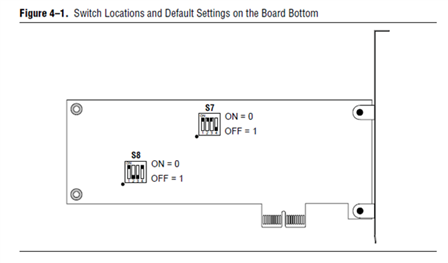Hi !
I've just received the Cyclone IV GX Transceiver Starter Board.
I took some pictures and I wrote a document.
I grabbed the quick start guide that came with the board and I read the section „Keep Your Board Current with the Board Update Portal”.
Then I decided to take a look at the „Board Update Portal design example” which includes a NIOS II embedded processor, an Ethernet MAC and a webpage.
This design is stored in separate section of board flash memory, the „factory” portion.
I’ve connected the Ethernet cable to a DHCP enabled network, then I powered the board, but nothing appeared on the LCD.
Reading the user guide (available at http://www.altera.com/literature/ug/ug_civgx_trans_starter_kit.pdf), I checked the dipswitch configuration.
Initially, all the switches were off.
Reading a bit more, I found out that switches must be configured to match default settings and I configured them as specified in the user guide:
I’ve reconnected the board to the network, and finally an ip appeared on the lcd screen: 172.16.51.192.
Writing http://172.16.51.192/ in the web browser, the Board Update Portal appeared.
This page contains links to kit specific resources from the Altera website, a form for uploading a new design to the flash and a nice presentation of the board.
The remote update feature is very interesting because it can be used to reconfigure an embedded FPGA system from remote, using the Web Update Portal.
When I connected the board to an USB port of a PC running Windows 7 64 bit, a popup appeared and it said that it has detected USB-Blaster but no driver has been found.
Pointing the driver update wizard to Quartus II installation folder (as suggested at http://www.altera.com/download/drivers/usb-blaster/dri-usb-blaster-vista.html), the embedded USB-Blaster installed correctly and I was able to use the Board Test System.
I configured the FPGA with GPIO, Memory and Ethernet Design, then I went to the Ethernet tab. This demo uses an embedded Nios II core to run a simple socket server. The board requested an ip from the DHCP server, then I could use the simple socket server to toggle the user leds .. very nice.
A button from the Board Test System application captured my attention: "Power Monitor".
100 mW while running the simple socket server .. that's not bad for a FPGA ! When I read 65 W on the power adapter I thought that this board is power hungry.
I like the board .. having worked mostly as a networking software engineer and system administrator, I am amazed by the flexibility of these devices - hardware becomes almost as flexible as software. I think that Cyclone IV family introduces new posibilities for custom hardware.
I'll play a bit more, then I'll come back !


